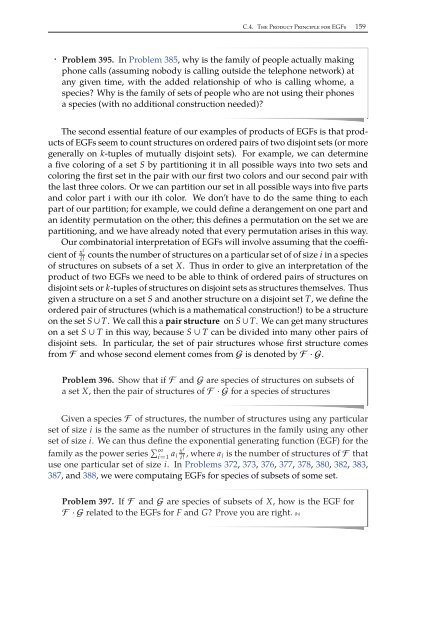Combinatorics Through Guided Discovery, 2004a
Combinatorics Through Guided Discovery, 2004a
Combinatorics Through Guided Discovery, 2004a
Create successful ePaper yourself
Turn your PDF publications into a flip-book with our unique Google optimized e-Paper software.
C.4. The Product Principle for EGFs 159<br />
· Problem 395. In Problem 385, why is the family of people actually making<br />
phone calls (assuming nobody is calling outside the telephone network) at<br />
any given time, with the added relationship of who is calling whome, a<br />
species? Why is the family of sets of people who are not using their phones<br />
a species (with no additional construction needed)?<br />
The second essential feature of our examples of products of EGFs is that products<br />
of EGFs seem to count structures on ordered pairs of two disjoint sets (or more<br />
generally on k-tuples of mutually disjoint sets). For example, we can determine<br />
a five coloring of a set S by partitioning it in all possible ways into two sets and<br />
coloring the first set in the pair with our first two colors and our second pair with<br />
the last three colors. Or we can partition our set in all possible ways into five parts<br />
and color part i with our ith color. We don’t have to do the same thing to each<br />
part of our partition; for example, we could define a derangement on one part and<br />
an identity permutation on the other; this defines a permutation on the set we are<br />
partitioning, and we have already noted that every permutation arises in this way.<br />
Our combinatorial interpretation of EGFs will involve assuming that the coefficient<br />
of xi<br />
i!<br />
counts the number of structures on a particular set of of size i in a species<br />
of structures on subsets of a set X. Thus in order to give an interpretation of the<br />
product of two EGFs we need to be able to think of ordered pairs of structures on<br />
disjoint sets or k-tuples of structures on disjoint sets as structures themselves. Thus<br />
given a structure on a set S and another structure on a disjoint set T, we define the<br />
ordered pair of structures (which is a mathematical construction!) to be a structure<br />
on the set S ∪ T. We call this a pair structure on S ∪ T. We can get many structures<br />
on a set S ∪ T in this way, because S ∪ T can be divided into many other pairs of<br />
disjoint sets. In particular, the set of pair structures whose first structure comes<br />
from F and whose second element comes from G is denoted by F·G.<br />
Problem 396. Show that if F and G are species of structures on subsets of<br />
a set X, then the pair of structures of F·Gfor a species of structures<br />
Given a species F of structures, the number of structures using any particular<br />
set of size i is the same as the number of structures in the family using any other<br />
set of size i. We can thus define the exponential generating function (EGF) for the<br />
family as the power series ∑ ∞<br />
i=1 a i xi<br />
i! , where a i is the number of structures of F that<br />
use one particular set of size i. In Problems 372, 373, 376, 377, 378, 380, 382, 383,<br />
387, and 388, we were computaing EGFs for species of subsets of some set.<br />
Problem 397. If F and G are species of subsets of X, how is the EGF for<br />
F·Grelated to the EGFs for F and G? Prove you are right. (h)


















